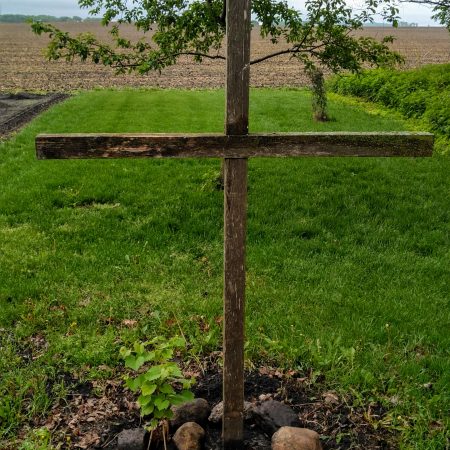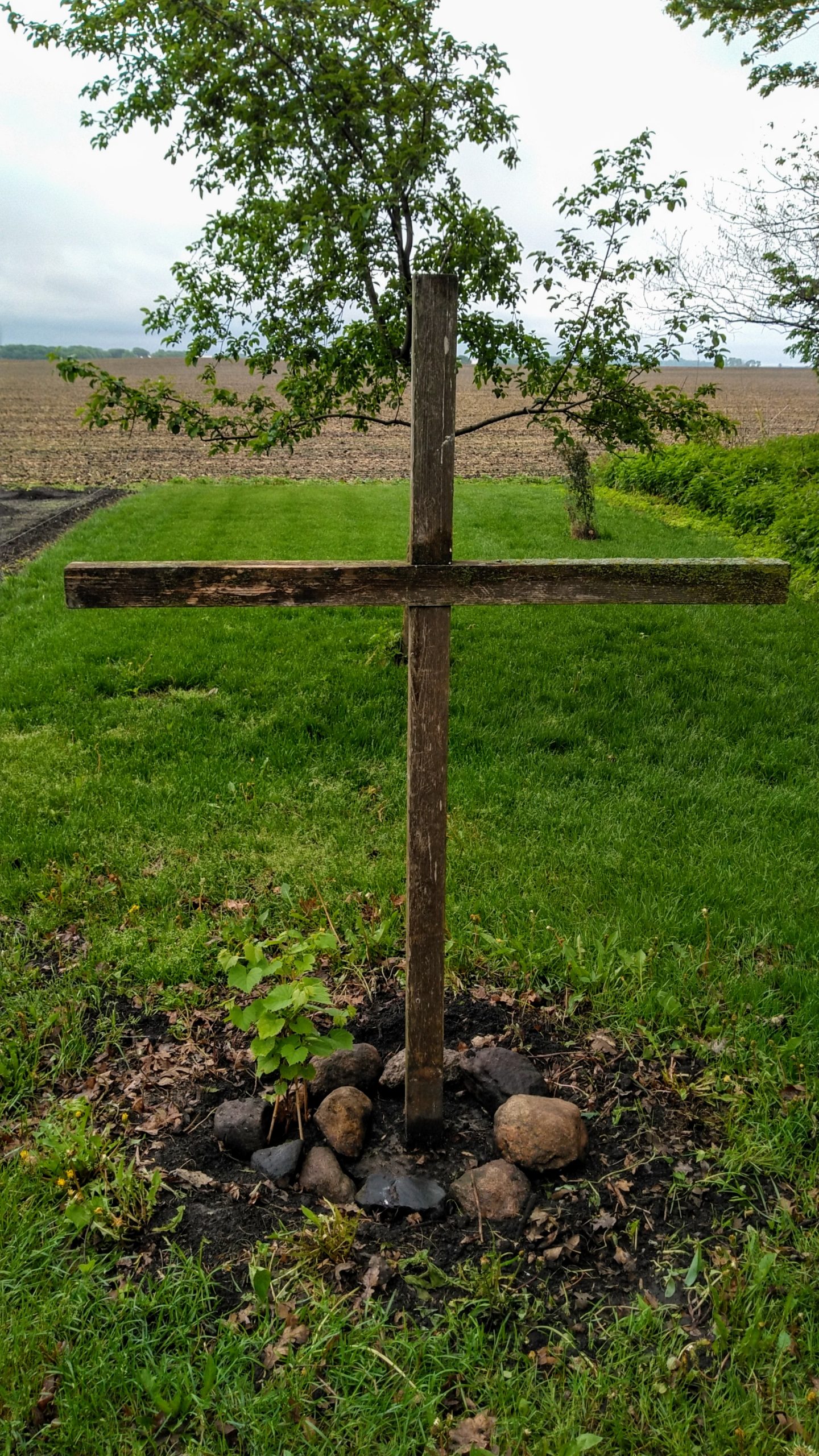
We built our family home on the shore of a lake that had been drained over a hundred years ago. As a result, our yard to the east (Or “the lower back yard” as I call it.) is lush and fertile. It had never been farmed, so once the trees, brush, nettles, and giant ragweed had been cleared and planted to grass and a garden established, it left an area with thick green grass and tomato plants that bend even the stoutest cages every year under the weight of their abundance.
Directly outside my bedroom window, about thirty feet from the house, there was a small tree that had died. A wood vine had grown up that tree and curled around the top. The result looked like one of those trees we all used to draw in kindergarten —a lollipop tree, if you will. It wasn’t something I or my wife had planned. God just kind of blessed us with it.
We decided a small pond would look wonderful in front of that lollipop tree, and a friend gave us a number of pond liners. (Lawn ponds were all the rage as this was taking place.) So, one day I set about digging said pond with my tractor and bucket.
I soon had a pretty large hole and, just as I was getting to the point where it looked about the right size, I got a little too close to that wood vine, hooked it by the root, and inadvertently killed it.
Guys and power tools. It’s an age-old story.
So, I decided a grape vine would be a wonderful replacement for the wood vine. It would look wonderful and I would get to make grape jelly as a bonus. And who doesn’t like toast with homemade grape jelly, right?
This necessitated a trip to the local nursery where I picked out a variety of grape vine called “Red Swenson.”
I planted “old Red” right where the wood vine used to grow, and he climbed up that little dead tree and became lush and green that first summer. He yielded a bounteous crop of beautiful grapes his second summer and I had to go buy some fine netting to keep the birds from enjoying the crop before I could make jelly from them.
I did indeed make jelly and it was delicious. There were so many grapes, I put the excess in plastic bags and froze them.
(Side note: At some point in this story, I came to my senses and filled in the hole where the pond was supposed to go. I believe this occurred once I fully understood the maintenance requirements of a pond –as did all the people who had once made ponds in one’s yard all the rage.)
Red continued to flourish, but the little dead tree rotted off at the base and one day I found Red lying in the lawn. I tried propping up Red and the remains of the little tree with a steel fence post, but it was unstable and looked like a one-legged man with a cane.
So, I decided to replace the dead tree with a cross.
It seemed so fitting. The theme of grapes and grapevines are woven throughout the Bible. Jesus even used a grapevine as a metaphor for Himself.
“Yes, I am the vine; you are the branches. Those who remain in me, and I in them, will produce much fruit. For apart from me you can do nothing. John 15:5 (NLT)
So, I bought some cedar posts and built a cross in my backyard.
Red trained easily to the new cross arbor and grew and thrived there. Each morning when I wake up and look out my bedroom window, I am treated to the sight of a cross covered in a lush grape vine.
And then, as the years wore on, Red stopped bearing grapes. He would get little green clusters in the early spring that were supposed to turn into my jelly-making fruit, but they would shrivel up and produce nothing.
I thought I was pruning Red wrong, so I studied up on that, but it didn’t seem to make any difference.
I asked questions of people who knew about these things and did internet searches, but to no avail. I considered possible problems with fertility and pH, or perhaps some interaction with the cedar of the cross, but none of that made any sense.
Alas, it seemed to me that old Red was just worn out.
So, I went to the nursery and decided on a new variety called, “Valiant,” which my wife quickly dubbed “Prince Valiant.” The tag said Prince Valiant was winter hardy to -40, so there were no worries there. Further research said Valiant was developed (are you reading this Allen Jones?) in South Dakota and would yield 20-40 pounds of grapes per year!
That all sounded very good, so last Friday night as the sun was setting, I decided to dig up old Red and put Prince Valiant in his rightful place of honor. I had 15 minutes before dark, but how long could it take to dig a hole for a little grape vine, right?
As I attempted to sink the shovel into the soil next to old Red, I quickly discovered why he was no longer yielding.
I had long known there were some little forest-dwelling plants growing at the base of that cross, but they actually looked nice and I had never thought they amounted to much.
I was wrong.
There we actual trees intertwined and intermingled with Red’s vine!
It quickly got dark and it was obvious I would have to reassess and regroup the next day.
The following morning, I came back with a shovel, a hand ax, and a pickax. As I got to work, I discovered that in the little space Red occupied there were no less than TEN trees that had their roots intertwined with Reds! One of those trees was over an inch in diameter at the base!
I had been sorely, sorely neglectful.
Now, for any of you who have done any of this kind of work before, you know that even a very small tree with a trunk less than the diameter of a pencil is not something you can just pull up like a radish or a carrot. I could see that I had pruned off some of these small trees at ground level before, but their roots had already been established, and they simply grew up again stronger and more invasive than before.
And I could not help but remember Luke 3:9:
“The ax is already at the root of the trees, and every tree that does not produce good fruit will be cut down and thrown into the fire.” (NIV)
No, one does not remove even a small tree by yanking it out. It requires digging down and chopping out the roots with an ax. There is sweat and straining. It is hard, dirty work, but it is the only way.
And in that moment, literally kneeling at the foot of a cross with an ax in my hand, with dirt flying and the “thud” of the ax cutting through roots, I understood the harsh reality of that Bible verse.
Sin is not something to be waved off with a casual pass of the hand. It may look like nothing much, it may hide, it may even look not so bad in the right light, but it saps away, it steals from us, and it destroys what God intended for us.
Sin prevents us from bearing the fruit God enjoys.
—0—
It turned out there was no way to remove the roots of those invading trees without also removing Red. I had to pry him out with the pickax. If plants could scream, I’m sure Red would have been heard miles away.
Now, I do not know if Red will ever produce fruit again, but I dug a hole on the edge of the yard where he would have more sunshine and less competition from trees and carefully planted and watered him. I pounded in a steel fence post to once again prop him up temporarily. I felt I owed him that since his lack of fruitfulness was far more my fault than his. As I write this two days later, God has sent both rain and sunshine on him and his leaves have not withered. I believe he may have even grown a couple of new leaves. Time will tell.
And yes, Prince Valiant now sits at the foot of the cross. On a whim, I looked up the definition of “valiant.” It means “possessing or showing courage or determination.” So yes, dear Prince, I promise to be more courageous and determined to pull out those little tiny weeds before they become giant trees that choke you out and negate your fruitfulness.
Today’s Praise
Then Jesus told this story: “A man planted a fig tree in his garden and came again and again to see if there was any fruit on it, but he was always disappointed. Finally, he said to his gardener, ‘I’ve waited three years, and there hasn’t been a single fig! Cut it down. It’s just taking up space in the garden.”
“The gardener answered, ‘Sir, give it one more chance. Leave it another year, and I’ll give it special attention and plenty of fertilizer. If we get figs next year, fine. If not, then you can cut it down.’” Luke 13:6-9 (NLT)

